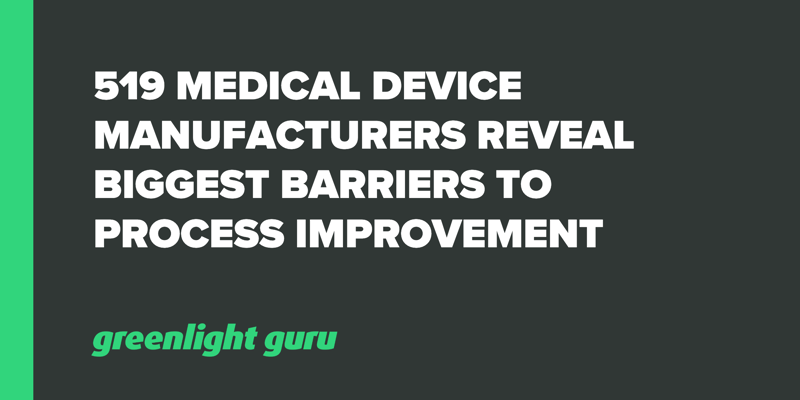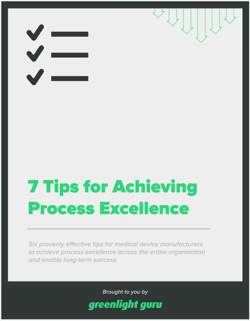519 Medical Device Manufacturers Reveal Biggest Barriers to Process Improvement

In the medical device industry, there’s a lot outside of our control. The market shifts. New, innovative products replace old, inefficient ones. Regulations and standards change, ushering in new compliance requirements.
That’s why it’s especially important to be proactive about everything inside of your control.
In our 2020 State of Medical Device Product Development and Quality Management report, we surveyed 519 medical device manufacturers from around the world. These industry professionals reported an array of challenges that create significant barriers to process improvement in their respective roles and company operations.
In this article, we’ll examine the top barriers that prevent medical device manufacturers from making critical process improvements by looking at the source of the issues, the immediate and long-term impacts inaction, and how you can overcome these barriers with a renewed approach.
FREE DOWNLOAD: Get our 7 provenly effective tips for achieving process excellence by clicking here.
Barriers Preventing Manufacturers from Improving Processes
Quality is a critical component in same way, shape, or form for every role in the medical device industry. Data-driven insights from our report shows, however, that quality doesn't get the attention and resources it needs.
Medical device manufacturers are grappling to overcome a number of significant barriers to improvement in their day-to-day jobs. Resource shortages, insufficient budgets, and misaligned team/management priorities top the list of biggest barriers preventing manufacturers from improving their processes.
As a result, product development and quality management activities suffer, a concerning problem for the medical device industry as a whole.
Processes left stagnant can lead to noncompliances which create unnecessary risk, leaving medical device manufacturers in a vulnerable position. If you don't have a quality procedure in place to effectively track and address complaints, for instance, you open the door for potential citations, product recalls, and harm to patients.
Let’s examine this data to get a better understanding of these barriers and their impacts.
Resource shortages
Resource shortages were one of the most commonly cited barriers preventing medical device manufacturers from making necessary improvements.
While resource concerns were not reported as a major challenge by quality professionals, 55% of product development teams identified resource shortages as the biggest barrier holding them back from achieving maximum efficiency in developing their medical device.
Resource shortage problems can be attributed to a number of things, a competitive market that dictates placement of top talent and budgetary constraints being two common contributing factors.
Staff shortages shortages can also be a symptom of a larger problem that exists within the company, a problem that must be addressed on the cultural level. The key, then, is to focus efforts on instilling a quality culture that every member of the organization is proud to be apart of and help foster.
Insufficient Budgets
Medical device manufacturers can only do so much with the financial means available to them.
Another common theme driven from our report is the lack of a sufficient budget to make the improvements teams want, and need, to make.
Quality teams looking to improve their processes frequently run up against constraints relating to their budget. Almost half—44%—reported that insufficient budgets became the barrier to doing so.
Product development teams looking to improve their processes discovered the same problem in their role, with 37% reporting insufficient funds as a major barrier to improvement.
Misaligned priorities between team and management
Both resource and budget shortages point to another problem: buy-in from management and key stakeholders.
Many companies in the medical device industry profess a dedication to quality, but that commitment is borne out in the resource and budget data we presented earlier.
Nearly three out of ten medical device manufacturers reported a lack of management buy-in as a barrier to improving product development and quality processes. Without executive engagement and support, companies struggle to make the business case for investments that would aid necessary improvements.
Even that doesn’t always come easily. More than one third of respondents in quality and regulatory roles experienced some level of resistance from management to their change efforts, while attributing internal bureaucracy served as the next biggest barrier to quality process improvement.
Whether the resistance is intentional or not, done by a manager or by the company’s red tape, a significant number of medical device manufacturers struggle to improve their product development and quality processes as a result.
Conflicting beliefs on the role of quality
Many companies in the medical device industry do not treat quality as an asset, rather it is treated as a hurdle to cross or checkbox to complete.
When companies devalue quality and treat it as either one task among many or a necessary evil to ensure compliance, there will be hesitance to invest in the time, money, and resources that are needed to produce any real value.
One survey respondent, for instance, shared that their “company does not prioritize resources for QA[...] and sees the function of the department as required for compliance with the law only.”
When quality is seen (and treated) as an asset, it only makes sense to invest in it. When quality is merely a requirement, one could justify keeping resources to a bare minimum just enough to satisfy what's needed for compliance.
Legacy QMS Tools Hold Medical Device Manufacturers Back
The lure of legacy quality management systems is powerful, and our data validates this belief.

As depicted in the chart above, a majority of manufacturers in the medical device industry carry out design control, risk management, and quality management activities using legacy tools.
Why? Well, according to one respondent, there’s “no need to change as long as there is enough profit.”
For many medical device companies, however, “enough” isn’t enough. As market challenges intensify and regulatory shifts emerge, it becomes more important to get ahead and stay ahead.
The better your company is performing, the more cushion you have when factors out of your control arise. Without the support of best-in-class tools that enable process improvements, medical device manufacturers risk falling behind and the competition taking their spot.
Legacy Tools aren’t Purpose-built for Medical Devices
Legacy tools don’t help manufacturers improve activities and tasks, rather they can impede the process.
More than half of manufacturers reported using legacy tools to support their design controls and risk management, as well as quality management processes. Legacy tools, like Microsoft Excel and Dropbox, are not designed to support the delicate nature and functions of a medical device.
There’s a gap between systems that are designed for the medical device industry and systems that aren’t. This purpose-built gap makes other barriers cited above even more challenging.
Without built-in templates and workflows that suit the medical device industry, product development and quality teams have to reengineer and revalidate constantly. Without document version control, manufacturers end up chasing signatures and managing paper instead of pursuing improvements that will yield True Quality medical devices.
Fear of the [un]known with Changing QMS Solutions
Medical device manufacturers are often tempted to settle with tools that are “good enough” due to the preconceived fear that uprooting an existing quality system will be too big an undertaking. The time and costs associated with such an endeavor may be hard to justify without considering all of the benefits a new system has to offer.
At Greenlight Guru, we recommend right-sizing your QMS. That means scaling your QMS up or down in complexity to fit the size and needs of your business. If you’re just starting out, your company doesn’t need the extensive processes and capabilities that an established 200-person company may need from a quality management system.
A QMS that’s light on specifications and full of vague language is hard to use; a QMS heavy on specifications and full of burdensome details is hard to follow. Implement a system that works for you instead of working overtime to make your system work.
How Medical Device Manufacturers can avoid inEfficiencies
The struggle to move swiftly is one of the biggest and most frustrating problems for medical device companies.
Unfortunately, most manufacturers aren’t as efficient as they’d like to be.
Process Inefficiencies cause Unnecessary distractions
Only 7% of the companies surveyed said that they consider themselves to be highly efficient throughout the process of bringing a new device to market.
Every moment your device is mired in product development or operations are put on hold to investigate a quality event is a moment when your company is falling behind. And your competitors will gladly take your spot if you let them.
Process inefficiencies can put added pressure on companies to invest in remediation methods that merely put a bandaid on the problem. The solution starts with a proactive approach to building efficient, malleable processes that can be easily tweaked for improvements as needed.
Teams must scrutinize their processes on an ongoing basis to find ways to improve them, and be given the means to make such improvements; otherwise, the overall state of internal processes will naturally worsen over time.
Design controls monopolize manufacturers time
Inefficient processes abound in even the best companies, so the key is looking for opportunities to create new, creative ways to gain efficiency. You can build the right levers with a relatively low amount of effort for huge gains.
For many medical device manufacturers, a high-leverage opportunity lies within your design controls.
Many survey respondents cited different aspects of design controls as challenges due to inefficient processes that are involved.
The biggest pain points with design controls involve:
- Managing a “pile” of documents (55%)
- Managing the Design History File (42%)
- Ensuring traceability throughout the Total Product Lifecycle (53%)
The Design History File (DHF) came up a few times. Nearly half of the respondents reported that it was a major challenge to manage their DHF. This isn’t surprising when you dig deeper into the data.
The average respondent said it took 212 hours, or five-and-a-half weeks of work hours, to complete a DHF. Keep in mind, this is the average response, meaning many of our respondents take even longer to complete a DHF. It’s no wonder it's such a big pain point.
Traceability is another common challenge. Eight out of ten respondents can not document closed-loop traceability (CLT) in real time. Closed-loop traceability is defined as the ability to connect people, processes, and data seamlessly across the value chain.

About a third of manufacturers said that documenting CLT requires substantial effort, and almost half report it requiring modest effort. However you slice it, for the vast majority of medical device companies, CLT is a painstaking process.
Inabilities to demonstrate CLT causes inefficiencies now, but once EU MDR takes effect in 2021, these inefficiencies will only cascade since the regulation requires total lifecycle traceability.
Manufacturers that haven’t transitioned their QMS to comply with the new MDR will only fall more behind and struggle with compliance requirements that must be followed in order to legally market a medical device in Europe.
document management system is working against manufacturers
Document management involves a lot of simple tasks that together make up a very complex system.
One respondent of our survey said one of their greatest challenges was “the amount of simple tasks that take time and distract from being proactive.”
Inefficient document management systems compound the otherwise expected challenges that come with managing and controlling documents. Simple tasks turn into dense, complex activities that can consume a large portion of manufacturers' time.
Good news, there is a better way.
Greenlight Guru’s advanced document management software provides a fully connected environment for teams to gain full visibility into their secure repository of documents and records associated with every stage of the medical device lifecycle.
The purpose-built platform cuts the time it takes to build out a traceability matrix from hours or days to just minutes, streamlines report management, and generates a DHF on-demand in minutes.
Remember that number from earlier—212 hours to complete a DHF? Greenlight Guru's software will generate your DHF on-demand. What would you do with 212 work hours back? Maybe it’s time you tried Greenlight Guru and found out.
FREE DOWNLOAD: Get our 7 provenly effective tips for achieving process excellence by clicking here.
Opportunity for Medical Device Manufacturers
We’ve covered the biggest barriers that prevent medical device manufacturers from making key process improvements. These aren’t insignificant issues that you can simply write off and ignore. Many of which point to systemic issues within a company’s systems, processes, and culture.
Once you get to the bottom of these issues, you'll find the opportunities you can seize to make the necessary process improvements and achieve outsized results.
Imagine if it used to take your company more than five weeks to generate a DHF, but now takes only minutes. Now imagine scaling the benefits of that one change to many that span across your entire organization.
This is the kind of transformational outcome you can experience with the right approach and support to help you along the way and make these barriers disappear.
Looking for an all-in-one QMS solution to advance the success of your in-market devices that can integrate your post-market activities with product development efforts? Click here to take a quick tour of Greenlight Guru's Medical Device QMS software →
Jon Speer is a medical device expert with over 20 years of industry experience. Jon knows the best medical device companies in the world use quality as an accelerator. That's why he created Greenlight Guru to help companies move beyond compliance to True Quality.
Related Posts
[VIDEO] 4 Medical Device Manufacturing Best Practices for a Successful Design Transfer (Approve Phase)
Abbreviated 510(k): Substantial Equivalence Through Performance Criteria
5 Most Common Problems with your CAPA Process
Get your free resource
7 Tips for Achieving Process Excellence











